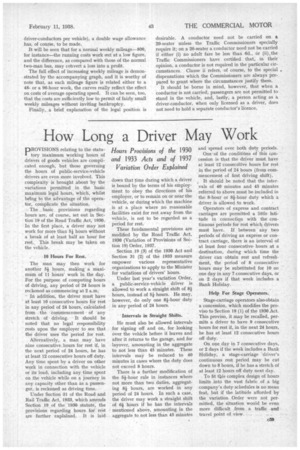How Long a Driver May Work Hours Provisions of the
Page 109

If you've noticed an error in this article please click here to report it so we can fix it.
1930 and 1933 Acts and of 1937 Variation Order Explained PROVISIONS relating to the statutory maximum working hours of drivers of goods vehicles are complicated enough, but those governing the hours of public-service-vehicle drivers are even more involved. This complexity is brought about by the variations permitted in the basic maximum legal hours, which, whilst being to the advantage of the operator: complicate the situation.
The basic provisions regarding hours are, of course, set out in Section 19 of the Road Traffic Act, 1930. In the first place, a driver may not . work for more than 54 hours without a break of at least half an hour for rest.. This break may be taken on the vehicle.
10 Hours For Rest.
The man may then work for another 54 hours, malring• a maximum of 11 hours' work in the day. For the purpose of computing hours of driving, any period of 24 hours is reckoned as commencing at 2 a.m.
• In addition, the driver must have • at least 10 consecutive hours for rest in any period of 24 hours, calculated from the commencement of any stretch of driving. It should be noted that no legal responsibility rests upon the employer to see that the driver uses the period for rest.
Alternatively, a man may have nine consecutive hours for rest if, in the next period of 24 hours, he has at least 12 consecutive hours off duty. Any time spent by a driver on other work in connection with the vehicle or its load, including any time spent on the vehicle while on a journey in any capacity other than as a passenger, is reckoned as driving time.
Under Section .31 of the Road and Rail Traffic Act, 1933, which amends Section 19 of the 1930 statute, the provisions regarding hours for rest are further explained. It is laid down that time during which a driver is bound by the terms of his employment to obey the directions of his employer, or to remain on or near the vehicle, or during which the machine . is at a place where no reasonable facilities exist for rest away from the vehicle, is not to be regarded as a • period for rest.
These fundamental provisions are modified by the Road Traffic Act, 1930 (Variation of Provisions of Section 19) Order, 1937.
Section 19 (3) of the 1930 Act and Section 31 (2) of the 1933 measure empower various representative organizations to apply to the Minister for variations of drivers' hours.
Under last year's variation Order, a public-service-vehicle driver is allowed to work a straight shift of 84 hours, instead of 54 hours. He may, however, do only one 84-hour duty in any period of 24 hours.
'Intervals in Straight Shifts.
He must also be allowed intervals for signing off and on, for looking Over the vehicle before it leaves and after it returns to the garage, and for layover, amounting in the aggregate to not less than 45 minutes. These intervals may be reduced to 40 minutes in cases where the duty does not exceed 8 hours.
There is a further modification of the 54-hour rule in instances where not more than two duties, aggregating 84 hours, are worked in any period of 24 hours. In such a case, the driver may work a straight shift of 64 hours if he has the intervals mentioned above, amounting in the aggregate to not less than 45 minutes
and spread over both duty periods.
One of the conditions of this concession is that the driver must have at least 12 consecutive hours for rest in the period of 24 hours (from commencement of first driving shift).
_ It should be noted that the intervals of 40 minutes and 45 minutes referred to above must be included in the 8-hour or 84-hour duty which a driver is allowed to work.
Operators of express and contract carriages are permitted a little latitude in connection with the continuous periods for rest which drivers must have. If between any two periods of driving an express or contract carriage, there is an interval of at least four consecutive hours at a destination, during which time the driver can obtain rest and refreshment, the period of 8 consecutive hours may be substituted for 10 on one day in any 7 consecutive days, or on 2 days if that week includes a Bank Holiday.
Help For Stage Operators.
Stage-carriage operators also obtain a concession, which modifies the proviso to Section 19 (1) of the 1930.Act. This proviso, it may be recalled, permits a driver to have 9 consecutive hours for rest if, in the next 24 hours, he has at least 12 consecutive hours off duty.
On one day in 7 consecutive days, or 2 days if the week includes a Bank Holiday, a stage-carriage driver's continuous rest period may be cut down to 8 hours, if he has a stretch of at least 12 hours off duty next day.
To fit this complex design of hours limits into the vast fabric of a big company's duty schedules is no mean feat, but if the latitude afforded by the variation Order were not permitted, the situation would be even more difficult from a traffic and travel ,point of view. ..




























































































































































